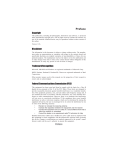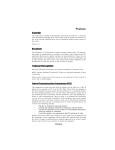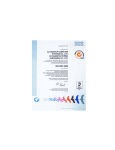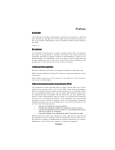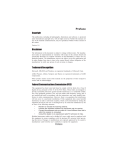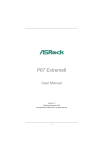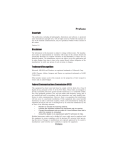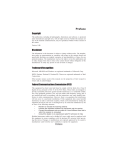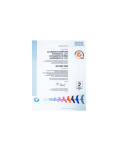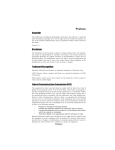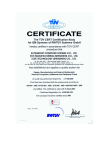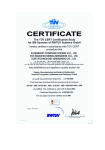Download ECS X48T-A motherboard
Transcript
Preface Copyright This publication, including all photographs, illustrations and software, is protected under international copyright laws, with all rights reserved. Neither this manual, nor any of the material contained herein, may be reproduced without written consent of the author. Version 1.0A Disclaimer The information in this document is subject to change without notice. The manufacturer makes no representations or warranties with respect to the contents hereof and specifically disclaims any implied warranties of merchantability or fitness for any particular purpose. The manufacturer reserves the right to revise this publication and to make changes from time to time in the content hereof without obligation of the manufacturer to notify any person of such revision or changes. Trademark Recognition Microsoft, MS-DOS and Windows are registered trademarks of Microsoft Corp. MMX, Pentium, Pentium-II, Pentium-III, Celeron are registered trademarks of Intel Corporation. Other product names used in this manual are the properties of their respective owners and are acknowledged. Federal Communications Commission (FCC) This equipment has been tested and found to comply with the limits for a Class B digital device, pursuant to Part 15 of the FCC Rules. These limits are designed to provide reasonable protection against harmful interference in a residential installation. This equipment generates, uses, and can radiate radio frequency energy and, if not installed and used in accordance with the instructions, may cause harmful interference to radio communications. However, there is no guarantee that interference will not occur in a particular installation. If this equipment does cause harmful interference to radio or television reception, which can be determined by turning the equipment off and on, the user is encouraged to try to correct the interference by one or more of the following measures: • • • • Reorient or relocate the receiving antenna Increase the separation between the equipment and the receiver Connect the equipment onto an outlet on a circuit different from that to which the receiver is connected Consult the dealer or an experienced radio/TV technician for help Shielded interconnect cables and a shielded AC power cable must be employed with this equipment to ensure compliance with the pertinent RF emission limits governing this device. Changes or modifications not expressly approved by the system’s manufacturer could void the user’s authority to operate the equipment. Preface ii Declaration of Conformity This device complies with part 15 of the FCC rules. Operation is subject to the following conditions: • • This device may not cause harmful interference, and This device must accept any interference received, including interference that may cause undesired operation Canadian Department of Communications This class B digital apparatus meets all requirements of the Canadian Interferencecausing Equipment Regulations. Cet appareil numérique de la classe B respecte toutes les exigences du Réglement sur le matériel brouilieur du Canada. About the Manual The manual consists of the following: Chapter 1 Describes features of the motherboard. Go to H page 1 Introducing the Motherboard Describes installation of motherboard components. Chapter 2 Installing the Motherboard Go to H page 7 Provides information on using the BIOS Setup Utility. Chapter 3 Using BIOS Go to Chapter 4 Using the Motherboard Software TM ATI CrossfireX Technology Support ® Intel Matrix Storage Manager RAID Configurations page 45 H page 51 Describes the Intel® Matrix Storage Manager RAID Configurations Go to Preface H Describes the ATI CrossfireXTM Technology Go to Chapter 6 page 25 Describes the motherboard software Go to Chapter 5 H H page 55 iii TABLE OF CONTENTS Preface i Chapter 1 1 Introducing the Motherboard 1 Introduction.....................................................................................1 Feature..............................................................................................2 Specifications...................................................................................4 Motherboard Components............................................................5 Chapter 2 7 Installing the Motherboard 7 Safety Precautions...........................................................................7 Choosing a Computer Case............................................................7 Installing the Motherboard in a Case...........................................7 Checking Jumper Settings..............................................................8 Setting Jumpers.......................................................................8 Checking Jumper Settings.......................................................9 Jumper Settings.......................................................................9 Installing Hardware..................................................................10 Installing the Processor.........................................................10 Installing Memory Modules..................................................12 Expansion Slots.....................................................................15 Connecting Optional Devices................................................17 Installing a Hard Disk Drive/CD-ROM/SATA Hard Drive...19 Installing a Floppy Diskette Drive........................................20 Connecting I/O Devices................................................................21 Connecting Case Components....................................................22 Front Panel Header...............................................................24 Chapter 3 25 Using BIOS 25 About the Setup Utility........................ ......................................... 25 The Standard Configuration..................................................25 Entering the Setup Utility......................................................25 Using BIOS......................................................................................26 Standard CMOS Setup...........................................................27 Advanced Setup.....................................................................30 Advanced Chipset Setup.........................................................32 Integrated Peripherals...........................................................33 iv Power Management Setup.................................................34 PCI/PnP Setup...................................................................35 PC Health Status...............................................................36 M.I.B (MB Intelligent BIOS)..............................................39 Load Default Settings........................................................42 Supervisor Password........................................................42 User Password..................................................................43 Save & Exit Setup..............................................................43 Exit Without Saving............................................................43 Updating the BIOS..............................................................44 Chapter 4 45 Using the Motherboard Software 45 About the Software CD-ROM......................................................45 Auto-installing under Windows XP/Vista..................................45 Running Setup....................................................................46 Manual Installation........................................................................50 Utility Software Reference............................................................50 Chapter 5 51 ATI CrossFireX™Technology Support 51 Requirements..................................................................................51 Installing a single graphics card..................................................51 Installing CrossFireX™ graphics cards......................................52 The Catalyst™ Control Center Dialog Box.................................54 View....................................................................................54 To Enable CrossFireX™...................................................54 Chapter 6 55 Intel®Matrix Storage Manager RAID Configurations 55 Before creating a RAID set...........................................................55 Entering Intel®Matrix Storage Manager RAID BIOS utility....56 Creating a RAID set.......................................................................57 Deleting a RAID set.......................................................................59 Resetting disks to Non-RAID......................................................60 Exiting Setup...................................................................................60 1 Chapter 1 Introducing the Motherboard Introduction Thank you for choosing the X48T-A motherboard. This motherboard is a high performance, enhanced function motherboard designed to support the LGA775 socket Intel® Yorkfield/Wolfdale/CoreTM 2 Extreme/CoreTM 2 Quad/CoreTM 2 Duo processors for high-end business or personal desktop markets. The motherboard incorporates the Intel X48 Northbridge (NB) and Intel ICH9-R Southbridge (SB) chipsets. The Northbridge supports a Front Side Bus (FSB) frequency of 1600/1333/1066/800 MHz using a scalable FSB Vcc_CPU. The memory controller supports DDR3 memory DIMM frequencies of 1600/1333/1066/800. It supports four DDR3 sockets with up to maximum memory of 8 GB. DDR3 Maximum memory bandwidth of 25.6 GB/s in dual-channel symmetric mode assuming DDR3 1600 MHz. High resolution graphics via two PCI Express slots, intended for Graphics Interface, is fully compliant to the PCI Express Base Specification revision 2.0. It supports the ATI CrossFireXTM Technology that allows you to install GPU graphics cards. The ICH9-R Southbridge supports two PCI slots which are PCI v2.3 compliant. In addition, two PCI Express x1 slots are supported, fully compliant to the PCI Express Base Specification, Revision 1.1. It implements an EHCI compliant interface that provides 480 Mb/s bandwidth for twelve USB 2.0 ports (six USB ports and three USB headers support additional six USB ports). The Southbridge integrates a Serial ATA host controller, supporting six SATA ports with maximum transfer rate up to 3.0 Gb/ s each. It supports Intel® Matrix Storage Technology, providing both AHCI and RAID 0, 1, 5 and 10 configuration. The motherboard is equipped with advanced full set of I/O ports in the rear panel, including PS/2 mouse and keyboard connectors, COM, one RCA SPDIFI port, one RCA SPDIFO port, one optical SPDIFO port, one ESATA port, six USB ports, two LAN ports and audio jacks for microphone, line-in and 6-ch line-out. Additionally, one Heat pipe heat sink is supported for NB & CPU heat dissipation. Introducing the Motherboard 2 Feature Processor The motherboard uses an LGA775 type of Intel® Yorkfield/Wolfdale/CoreTM 2 Extreme/CoreTM 2 Quad/CoreTM 2 Duo that carries the following features: • • Accommodates Intel® Yorkfield/Wolfdale/CoreTM 2 Extreme/CoreTM 2 Quad/CoreTM 2 Duo processors Supports a system bus (FSB) of 1600/1333/1066/800 MHz Chipset The X48 Northbridge (NB) and ICH9-R Southbridge (SB) chipsets are based on an innovative and scalable architecture with proven reliability and performance. X48 (NB) • • • • ICH9-R (SB) • • • • • • Supports 36-bit host bus addressing, allowing the CPU to access the entire 64 GB of the memory address space 2 GB/s point-to-point Direct Media Interface (DMI) to ICH9 (1 GB/s each direction) Supports 512 Mb and 1 Gb DDR3 DRAM technologies for x8 and x16 devices Two, 16-lane PCI Express ports intended for external device attach, compliant to the PCI Express* Base Specification revision 2.0 Enhanced DMA Controller, interrupt controller, and timer functions Compliant with PCI v2.3 specification Integrated SATA 3.0 Gb/s Host Controller Supports up to twelve USB 2.0 ports Integrated Gigabit LAN Controller Supports Intel® Matrix Storage Technology, providing both AHCI and RAID 0, 1, 5 and 10 configuration Memory • • • Supports DDR3 1600/1333/1066/800 DDR3 SDRAM with Dual-channel architecture Accommodates four unbuffered DIMMs Up to 2 GB per DIMM with maximum memory size up to 8 GB Audio • • Compliant with Intel High Definition Audio Codec 8-channel audio CODEC Onboard LAN (Optional) • • Intel Giga LAN Controller Realtek Giga LAN Controller Introducing the Motherboard 3 Expansion Options The motherboard comes with the following expansion options: • • • • • • Two PCI Express x16 slots for Graphic Interface Two PCI Express x1 slots Two 32-bit PCI v2.3 compliant slots One 40-pin IDE connector that supports two IDE devices One floppy disk drive interface Six 7-pin SATA connectors Integrated I/O The motherboard has a full set of I/O ports and connectors: • Two PS/2 ports for mouse and keyboard • One Heat pipe heat sink for NB & CPU heat dissipation • One Serial port • One RCA SPDIFI port • One RCA SPDIFO port • One optical SPDIFO port • One ESATA port • Six USB ports • Two LAN ports • Audio jacks for microphone, line-in and 6-ch line-out BIOS Firmware This motherboard uses AMI BIOS that enables users to configure many system features including the following: • • • • • Power management Wake-up alarms CPU parameters CPU and memory timing ECS M.I.B. BIOS The firmware can also be used to set parameters for different processor clock speeds. 1. Some hardware specifications and software items are subject to change without prior notice. 2. Due to chipset limitation, we recommend that motherboard be operated in the ambiance between 0 and 50 ° C. Introducing the Motherboard 4 Specifications • LGA775 socket for latest Intel® Yorkfield/Wolfdale/CoreTM 2 Extreme/CoreTM 2 Quad/CoreTM 2 Duo porcessors FSB 1600/1333/1066/800 MHz Chipset • • • Intel X48 & ICH9R North Bridge: Intel X48 South Bridge: Intel ICH9R Memory • • • • Dual-channel DDR3 memory architecture 4 x 240-pin DDR3 DIMM socket support up to 8 GB Supports DDR3 1600/1333/1066/800 DDR3 SDRAM XMP DDR3 Expansion Slots • • • 2 x PCI Express Gen 2.0 x16 slots 2 x PCI Express x1 slot 2 x PCI slots Storage • • • • • • • Support by Intel ICH9R 6 x Serial ATAII devices Supports RAID0, 1, 5, 10 Support by JMicron® JMB361 2 x Ultra DMA 133/100/66 device 4 x 240-pin DDR3 DIMM socket support up to 8 GB 1 x e-SATAII 3.0 Gb/s device Audio • Realtek ALC 888S supports 8-channel HD audio CPU • Dual Giga LAN • • Heat Pipe • Intel 82566DC GigaLAN Controller Realtek 8111B PCIE GigaLAN Controller 1 x ECS QooTechII Heat Pipe Rear Panel I/O • • • • • • • • 1 x PS/2 keyboard & PS/2 mouse connectors 6 x USB ports 1 x e-SATA port 1 x COM port 2 x RJ45 LAN connectors 1 x Audio port (1 Line in, 4 x Line out, 1 Optical SPDIF Out) 1 x RCA SPDIF Out connector (Orange) 1 x RCA SPDIF In connector (Yellow) Internal I/O • Connectors & Headers • • • • • • • • • • System BIOS • • • Form Factor • 1 x 24-pin ATX Power Supply connector & 8-pin 12V connector 1 x IDE connector 6 x Serial ATA connectors 3 x USB 2.0 headers support additional 6 USB ports 1 x Clear CMOS header 1 x Front panel header 1 x Front panel audio header 1 x CD_in header 1 x IrDA for SIR header 1 x BUZZER CPUFAN/SYSFAN connectors AMI BIOS with 16Mb SPI ROM Supports Plug and Play 1.0A, APM 1.2, Multi Boot, DMI Supports ACPI revision 1.0 specification ATX Size, 305mm x 244mm Introducing the Motherboard 5 Motherboard Components Table of Motherboard Components LABEL 1. CPU Socket 2. DDR3_1~4 3. CPU_FAN 4. ATX_POWER 5. FDD 6. SATA1~6 7. F_PANEL 8. F_USB1~3 9. CLR_CMOS 10. IR 11. IDE 12. CD_IN 13. F_AUDIO 14. PCI1~2 15. PCIEX16 PCIEX16_C 16. PCIE1~2 17. ATX4P1 18. ATX12V 19. SYS_FAN COMPONENTS LGA775 socket for Intel ® Yorkfield XE 1600FSB/Yorkfield/Wolfdale/CoreTM 2 Extreme/CoreTM 2 Quad/Intel ® Core TM 2 Duo 240-pin DDR3 SDRAM slots CPU cooling fan connector Standard 24-pin ATX power connector Floppy Disk Drive connector Serial ATA connectors Front panel switch/LED header Front Panel USB headers Clear CMOS jumper Infrared Header Primary IDE connector Analog audio input connector Front Panel Audio header 32-bit add-on card slots PCI Express slots for graphics interface 32-bit add-on card slots Auxiliary power connector for graphics card 8-pin +12V power connector System cooling fan connector This concludes Chapter 1. The next chapter explains how to install the motherboard. Introducing the Motherboard 6 Memo Introducing the Motherboard 7 Chapter 2 Installing the Motherboard Safety Precautions • • • • • Follow these safety precautions when installing the motherboard Wear a grounding strap attached to a grounded device to avoid damage from static electricity Discharge static electricity by touching the metal case of a safely grounded object before working on the motherboard Leave components in the static-proof bags they came in Hold all circuit boards by the edges. Do not bend circuit boards Choosing a Computer Case There are many types of computer cases on the market. The motherboard complies with the specifications for the ATX system case. First, some features on the motherboard are implemented by cabling connectors on the motherboard to indicators and switches on the system case. Make sure that your case supports all the features required. Secondly, this motherboard supports one floppy diskette drive and two enhanced IDE drives. Make sure that your case has sufficient power and space for all drives that you intend to install. Most cases have a choice of I/O templates in the rear panel. Make sure that the I/O template in the case matches the I/O ports installed on the rear edge of the motherboard. This motherboard carries an ATX form factor of 305 x 244 mm. Choose a case that accommodates this form factor. Installing the Motherboard in a Case Refer to the following illustration and instructions for installing the motherboard in a case. Most system cases have mounting brackets installed in the case, which correspond the holes in the motherboard. Place the motherboard over the mounting brackets and secure the motherboard onto the mounting brackets with screws. Ensure that your case has an I/O template that supports the I/O ports and expansion slots on your motherboard. Installing the Motherboard 8 Do not over-tighten the screws as this can stress the motherboard. Checking Jumper Settings This section explains how to set jumpers for correct configuration of the motherboard. Setting Jumpers Use the motherboard jumpers to set system configuration options. Jumpers with more than one pin are numbered. When setting the jumpers, ensure that the jumper caps are placed on the correct pins. The illustrations show a 2-pin jumper. When the jumper cap is placed on both pins, the jumper is SHORT. If you remove the jumper cap, or place the jumper cap on just one pin, the jumper is OPEN. SHORT This illustration shows a 3-pin jumper. Pins 1 and 2 are SHORT. Installing the Motherboard OPEN 9 Checking Jumper Settings The following illustration shows the location of the motherboard jumpers. Pin 1 is labeled. Jumper Settings Jumper Type Description Setting (default) 1-2: NORMAL CLR_CMOS 3-pin Clear CMOS 2-3: CLEAR CMOS Before clearing the CMOS, make sure to turn off the system. 1 CLR_CMOS To avoid the system unstability after clearing CMOS, we recommend users to enter the main BIOS setting page to “Load Default Settings” and then “Save Changes and Exit”. Installing the Motherboard 10 Installing Hardware Installing the Processor Caution: When installing a CPU heatsink and cooling fan make sure that you DO NOT scratch the motherboard or any of the surface-mount resistors with the clip of the cooling fan. If the clip of the cooling fan scrapes across the motherboard, you may cause serious damage to the motherboard or its components. On most motherboards, there are small surface-mount resistors near the processor socket, which may be damaged if the cooling fan is carelessly installed. Avoid using cooling fans with sharp edges on the fan casing and the clips. Also, install the cooling fan in a well-lit work area so that you can clearly see the motherboard and processor socket. Before installing the Processor This motherboard automatically determines the CPU clock frequency and system bus frequency for the processor. You may be able to change the settings in the system Setup Utility. We strongly recommend that you do not over-clock processors or other components to run faster than their rated speed. Warning: 1. Over-clocking components can adversely affect the reliability of the system and introduce errors into your system. Over-clocking can permanently damage the motherboard by generating excess heat in components that are run beyond the rated limits. 2. Always remove the AC power by unplugging the power cord from the power outlet before installing or removing the motherboard or other hardware components. This motherboard has an LGA775 socket. When choosing a processor, consider the performance requirements of the system. Performance is based on the processor design, the clock speed and system bus frequency of the processor, and the quantity of internal cache memory and external cache memory. Installing the Motherboard 11 CPU Installation Procedure The following illustration shows CPU installation components. A. Read and follow the instructions shown on the sticker on the CPU cap. B. Unload the cap · Use thumb & forefinger to hold the lifting tab of the cap. · Lift the cap up and remove the cap completely from the socket. C. Open the load plate · Use thumb & forefinger to hold the hook of the lever, pushing down and pulling aside unlock it. · Lift up the lever. · Use thumb to open the load plate. Be careful not to touch the contacts. D. Install the CPU on the socket · Orientate CPU package to the socket. Make sure you match triangle marker to pin 1 location. E. Close the load plate · Slightly push down the load plate onto the tongue side, and hook the lever. · CPU is locked completely. F. Apply thermal grease on top of the CPU. G. Fasten the cooling fan supporting base onto the CPU socket on the motherboard. H. Make sure the CPU fan is plugged to the CPU fan connector. Please refer to the CPU cooling fan user’s manual for more detail installation procedure. 1. To achieve better airflow rates and heat dissipation, we suggest that you use a high quality fan with 3800 rpm at least. CPU fan and heatsink installation procedures may vary with the type of CPU fan/ heatsink supplied. The form and size of fan/heatsink may also vary. 2. DO NOT remove the CPU cap from the socket before installing a CPU. 3. Return Material Authorization (RMA) requests will be accepted only if the motherboard comes with the cap on the LGA775 socket. Installing the Motherboard 12 Installing Memory Modules This motherboard accommodates four memory modules. It can support four 240-pin DDR3 1600/1333/1066/800. The total memory capacity is 8 GB. DDR3 SDRAM memory module table Memory module DDR3 DDR3 DDR3 DDR3 800 1066 1333 1600 Memory Bus 400 533 667 800 MHz MHz MHz MHz You must install at least one module in any of the four slots. Each module can be installed with 2 GB of memory; total memory capacity is 8 GB. The four DDR3 memory sockets (DDR3_1, DDR3_2, DDR3_3, DDR3_4) are divided into two channels and each channel has two memory sockets as following: ff Channel A: DDR3_1, DDR3_2 ff Channel B: DDR3_3, DDR3_4 Do not remove any memory module from its antistatic packaging until you are ready to install it on the motherboard. Handle the modules only by their edges. Do not touch the components or metal parts. Always wear a grounding strap when you handle the modules. Since the model supports one 1600 MHz XMP memory module on each channel, we can only plug two 1600 MHz XMP memory modules on the motherboard. Installing the Motherboard 13 Installation Procedure Refer to the following to install the memory modules. 1 2 3 4 5 6 This motherboard supports unbuffered DDR3 SDRAM . Push the latches on each side of the DIMM slot down. Align the memory module with the slot. The DIMM slots are keyed with notches and the DIMMs are keyed with cutouts so that they can only be installed correctly. Check that the cutouts on the DIMM module edge connector match the notches in the DIMM slot. Install the DIMM module into the slot and press it firmly down until it seats correctly. The slot latches are levered upwards and latch on to the edges of the DIMM. Install any remaining DIMM modules. Installing the Motherboard 14 Table A: DDR3 (memory module) QVL (Qualified Vendor List) The following DDR3 1600/1333/1066/800 memory modules have been tested and qualified for use with this motherboard. Type DDR3 800 Size Vendor 512 MB Nanya 1 GB HYNIX Aeneon Apacer 512 MB ELPIDA Hynix Kingston DDR3 1066 1GB DDR3 1333 1GB DDR3 1600 1GB 0649 NT5CB64M8AN-25D 0650 NT5CB64M8AN-BE HY5TQ1G831ZN F-S6 AEH93R10F 0737 Qimonda IDSH51-03A1F1C10F PC3-8500U-7-00-AP J53088ASE-AC-E HYMT164U64ZNF6-G8 AA ELPIDA J5308BASE-AC-E 07090W093 A-data M3OSS3H3I3120B5Z/Boxed Aeneon AEH93R10F 0737 Corsair CM3X1024-1066C7/Boxed Hynix HY5TQ1G831ZNFP-G8 J5308BASE-AC-E 07090W063 Kingston 2 GB Module Name Micron Hynix 7UD22D9JNL HY5TQ1G831ZNFP-G8 Corsair CM3X1024-1333C9/Boxed CM3X10241333C9DHX/Boxed Qimonda 0734 IDSH51-03A1F1D Kingston KHX13000D3LL/1G Installing the Motherboard 15 Expansion Slots Installing Add-on Cards The slots on this motherboard are designed to hold expansion cards and connect them to the system bus. Expansion slots are a means of adding or enhancing the motherboard’s features and capabilities. With these efficient facilities, you can increase the motherboard’s capabilities by adding hardware that performs tasks that are not part of the basic system. PCI1~2 Slots This motherboard is equipped with two standard PCI slots. PCI stands for Peripheral Component Interconnect and is a bus standard for expansion cards, which for the most part, is a supplement of the older ISA bus standard. The PCI slots on this board are PCI v2.3 compliant. PCIEX16/ PCIEX16_C Slots The PCI Express x16 slots are used to install an external PCI Express graphics card that is fully compliant to the PCI Express Base Specification revision 2.0. For CrossFireXTM information please refer to Chapter 5. PCIE1~2 Slots The PCI Express x1 slots are fully compliant to the PCI Express Base Specification revision 1.1. Before installing an add-on card, check the documentation for the card carefully. If the card is not Plug and Play, you may have to manually configure the card before installation. Installing the Motherboard 16 Follow these instructions to install an add-on card: 1 2 3 Remove a blanking plate from the system case corresponding to the slot you are going to use. Install the edge connector of the add-on card into the expansion slot. Ensure that the edge connector is correctly seated in the slot. Secure the metal bracket of the card to the system case with a screw. 1. For some add-on cards, for example graphics adapters and network adapters, you have to install drivers and software before you can begin using the add-on card. 2. The onboard PCI interface does not support 64-bit SCSI cards. Installing the Motherboard 17 Connecting Optional Devices Refer to the following for information on connecting the motherboard’s optional devices: F_AUDIO: Front Panel Audio header This header allows the user to install auxiliary front-oriented microphone and lineout ports for easier access. Pin 1 3 5 7 9 Signal Name Pin Signal Name PORT 1L 2 AUD_GND PORT 1R 4 PRESENCE# PORT 2R 6 SENSE_SEND PORT 2L 8 10 SENSE1_RETURN KEY SENSE2_RETURN SATA1~6: Serial ATA connectors These connectors are use to support the Serial ATA devices for the highest data transfer rates (3.0 Gb/s), simpler disk drive cabling and easier PC assembly. It eliminates limitations of the current Parallel ATA interface. But maintains register compatibility and software compatibility with Parallel ATA. Pin Signal Name 1 3 Ground 5 7 Pin Signal Name TX+ TX- 2 4 RXGround 6 - RX+ - Ground Installing the Motherboard 18 F_USB1~3: Front Panel USB headers The motherboard has six USB ports installed on the rear edge I/O port array. Additionally, some computer cases have USB ports at the front of the case. If you have this kind of case, use auxiliary USB connector to connect the front-mounted ports to the motherboard. Pin Signal Name Function 1 USBPWR 2 3 4 5 6 7 8 9 10 USBPWR Front Panel USB Power USB_FP_P0- USB Port 0 Negative Signal USB_FP_P1- USB Port 1 Negative Signal Front Panel USB Power USB_FP_P0+ USB Port 0 Positive Signal USB_FP_P1+ USB Port 1 Positive Signal GND GND Ground Ground Key No pin USB_FP_OC0 Overcurrent signal Please make sure that the USB cable has the same pin assignment as indicated above. A different pin assignment may cause damage or system hang-up. CD_IN: Analog Audio Input connector Pin 1 2 3 4 Signal Name Function CD_L CD In left channel GND Ground GND CD_R Ground CD In right channel IR: Infrared header The motherboard supports an Infrared (IR) data port. Infrared ports allow the wireless exchange of information between your computer and similarly equipped devices such as printers, laptops, Personal Digital Assistants (PDAs), and other computers. Pin 1 2 3 4 5 6 Signal Name Not Assigned Key +5V GND IR_TX IR_RX Function Not assigned No pin IR Power Ground IrDA serial output IrDA serial input Installing the Motherboard 19 Installing a Hard Disk Drive/CD-ROM/SATA Hard Drive This section describes how to install IDE devices such as a hard disk drive and a CDROM drive. About IDE Devices Your motherboard has one IDE interface. An IDE ribbon cable supporting two IDE devices is bundled with the motherboard. You must orient the cable connector so that the pin1 (color) edge of the cable corresponds to the pin 1 of the I/O port connector. IDE: IDE Connector This motherboard supports six high data transfer SATA ports with each runs up to 3.0 Gb/s. To get better system performance, we recommend users connect the CD-ROM to the IDE channel, and set up the hard dives on the SATA ports. IDE devices enclose jumpers or switches used to set the IDE device as MASTER or SLAVE. Refer to the IDE device user’s manual. Installing two IDE devices on one cable, ensure that one device is set to MASTER and the other device is set to SLAVE. The documentation of your IDE device explains how to do this. About SATA Connectors Your motherboard features six SATA connectors supporting a total of six drives. SATA refers to Serial ATA (Advanced Technology Attachment) is the standard interface for the IDE hard drives which are currently used in most PCs. These connectors are well designed and will only fit in one orientation. Locate the SATA connectors on the motherboard and follow the illustration below to install the SATA hard drives. Installing Serial ATA Hard Drives To install the Serial ATA (SATA) hard drives, use the SATA cable that supports the Serial ATA protocol. This SATA cable comes with a SATA power cable. You can connect either end of the SATA cable to the SATA hard drive or the connector on the motherboard. SATA cable (optional) SATA power cable Installing the Motherboard (optional) 20 Refer to the illustration below for proper installation: 1 2 3 Attach either cable end to the connector on the motherboard. Attach the other cable end to the SATA hard drive. Attach the SATA power cable to the SATA hard drive and connect the other end to the power supply. This motherboard supports the “Hot-Plug” function. Installing a Floppy Diskette Drive FDD: Floppy Disk Connector Connect the single end of the floppy connector to the onboard floppy connector firstly, and then connect the remaining plugs on the other end to the floppy drives correspondingly. You must orient the cable connector so that the pin 1 (color) edge of the cable corresponds to the pin 1 of the I/O port connector. Installing the Motherboard 21 Connecting I/O Devices The backplane of the motherboard has the following I/O ports: PS2 Mouse Use the upper PS/2 port to connect a PS/2 pointing device. PS2 Keyboard Use the lower PS/2 port to connect a PS/2 keyboard. Serial Port (COM) Use the COM port to connect serial devices such as mouse or fax/modems. ESATA Port Use this port to connect to an external SATA box or a Serial ATA port multiplier. Before connecting the ESATA cable, make sure to turn off the power of the external enclosure. LAN Ports Connect an RJ-45 jack to the LAN port to connect your computer to the Network. USB Ports Use the USB ports to connect USB devices. SPDIFO This jack connects to external digital audio output devices. SPDIFI This jack connects to external digital audio input devices. Optical SPDIF Output This jack connects to external optical digital audio output devices. Audio Ports Use the audio jacks to connect audio devices. The C port is for stereo line-in signal, while the E port is for microphone in signal. This motherboard supports audio devices that correspond to the A,B, and D port respectively. In addition, all of the 3 ports, B, and D provide users with both right & left channels individually. Users please refer to the following note for specific port function definition. A: Center & Woofer D: Front Out B: Back Surround E: Mic_in Rear C: Line-in - The above port definition can be changed to audio input or audio output by changing the driver utility setting. Installing the Motherboard 22 Connecting Case Components After you have installed the motherboard into a case, you can begin connecting the motherboard components. Refer to the following: 1 2 3 4 5 6 Connect the CPU cooling fan cable to CPU_FAN. Connect the system cooling fan connector to SYS_FAN. Connect the case switches and indicator LEDs to the F_PANEL. Connect the standard power supply connector to ATX_POWER. Connect the connector for graphics interface to ATX4P1. Connect the auxiliary case power supply connector to ATX12V. 1. Connecting 24-pin power cable The ATX 24-pin connector allows you to connect to ATX v2.x power supply. With ATX v2.x power supply, users please note that when installing 24-pin power cable, the latches of power cable and the ATX_POWER match perfectly. 24-pin power cable 2. Connecting 8-pin power cable The ATX12V power connector is used to provide power to the CPU. When installing 8-pin power cable, the latches of power cable and the ATX12V match perfectly. 8-pin power cable Installing the Motherboard 23 CPU_FAN: FAN Power Connector Pin Signal Name GND 1 2 3 4 +12V Sense PWM Function System Ground Power +12V Sensor PWM Users please note that the fan connector supports the CPU cooling fan of 1.1A ~ 2.2A (26.4W max) at +12V. SYS_FAN: System Cooling FAN Power Connector Pin Signal Name Function 1 GND System Ground 2 3 +12V Power +12V Sensor Sense ATX_ POWER: ATX 24-pin Power Connector Pin Signal Name 1 2 3 4 5 6 7 8 9 +3.3V 10 11 12 +12V Pin 13 14 15 16 17 18 19 20 21 +3.3V Ground +5V Ground +5V Ground PWRGD +5VSB 22 23 24 +12V +3.3V Signal Name +3.3V -12V Ground PS_ON Ground Ground Ground -5V +5V +5V +5V Ground ATX12V: ATX 12V Power Connector Pin Signal Name Pin 1 2 3 4 Ground 5 6 7 8 Ground Ground Ground Signal Name +12V +12V +12V +12V Installing the Motherboard 24 ATX4P1: Auxliary Power Connector for Graphics Interface Pin Signal Name 1 2 3 4 NC GND GND +12V Make sure to connect a 4-pin ATX power cable to ATX4P1; otherwise, the system will be unstable. Front Panel Header The front panel header (F_PANEL) provides a standard set of switch and LED headers commonly found on ATX or Micro ATX cases. Refer to the table below for information: Pin Signal Function Pin 2 Signal Function 1 HD_LED_P Hard disk LED(+) FP PWR/SLP *MSG LED(+) 3 HD_LED_N Hard disk LED(- ) 4 FP PWR/SLP *MSG LED(-) 5 RST_SW_N Reset Switch(-) 6 PWR_SW_P Power Switch(+) 7 RST_SW_P Reset Switch(+) 8 PWR_SW_N Power Switch(-) 9 RSVD Reserved 10 Key No pin * MSG LED (dual color or single color) Hard Drive Activity LED Connecting pins 1 and 3 to a front panel mounted LED provides visual indication that data is being read from or written to the hard drive. For the LED to function properly, an IDE drive should be connected to the onboard IDE interface. The LED will also show activity for devices connected to the SCSI (hard drive activity LED) connector. Power/Sleep/Message waiting LED Connecting pins 2 and 4 to a single or dual-color, front panel mounted LED provides power on/off, sleep, and message waiting indication. This concludes Chapter 2. The next chapter covers the BIOS. Installing the Motherboard 25 Chapter 3 Using BIOS About the Setup Utility The computer uses the latest “American Megatrends Inc.” BIOS with support for Windows Plug and Play. The CMOS chip on the motherboard contains the ROM setup instructions for configuring the motherboard BIOS. The BIOS (Basic Input and Output System) Setup Utility displays the system ’ s configuration status and provides you with options to set system parameters. The parameters are stored in battery-backed-up CMOS RAM that saves this information when the power is turned off. When the system is turned back on, the system is configured with the values you stored in CMOS. The BIOS Setup Utility enables you to configure: • • • • Hard drives, diskette drives and peripherals Video display type and display options Password protection from unauthorized use Power Management features The settings made in the Setup Utility affect how the computer performs. Before using the Setup Utility, ensure that you understand the Setup Utility options. This chapter provides explanations for Setup Utility options. The Standard Configuration A standard configuration has already been set in the Setup Utility. However, we recommend that you read this chapter in case you need to make any changes in the future. This Setup Utility should be used: • • • • • when changing the system configuration when a configuration error is detected and you are prompted to make changes to the Setup Utility when trying to resolve IRQ conflicts when making changes to the Power Management configuration when changing the password or making other changes to the Security Setup Entering the Setup Utility When you power on the system, BIOS enters the Power-On Self Test (POST) routines. POST is a series of built-in diagnostics performed by the BIOS. After the POST routines are completed, the following message appears: Press DEL to enter SETUP Using BIOS 26 Press the delete key to access the BIOS Setup Utility. CMOS Setup Utility -- Copyright (C) 1985-2008, American Megatrends, Inc. f Standard CMOS Setup f Advanced Setup f Advanced Chipset Setup f Integrated Peripherals f Power Management Setup f PCI/PnP Setup f PC Health Status fM.I.B. (MB Intelligent BIOS) Load Default Settings fSupervisor Password fUser Password Save & Exit Setup Exit Without Saving mnlk : Move Enter : Select +/-/: Value F10: Save F1:General Help F9: Optimized Defaults ESC: Exit v02.61 (C)Copyright 1985-2008, American Mega trends, Inc. Using BIOS The main menu of the Setup Utility displays a list of the options that are available. A highlight indicates which option is currently selected. Use the cursor arrow keys to move the highlight to other options. When an option is highlighted, execute the option by pressing <Enter>. Some options lead to pop-up dialog boxes that prompt you to verify that you wish to execute that option. Other options lead to dialog boxes that prompt you for information. Some options (marked with a triangle f) lead to submenus that enable you to change the values for the option. Use the cursor arrow keys to scroll through the items in the submenu. In this manual, default values are enclosed in parenthesis. Submenu items are denoted by a triangle f . The default BIOS setting for this motherboard applies for most conditions with optimum performance. It is not suggested to change the default values in the BIOS setup and the manufacture takes no responsibility to any damage caused by changing the BIOS settings. BIOS Navigation Keys The BIOS navigation keys are listed below: KEY ESC FUNCTION Exits the current menu mnlk Scrolls through the items on a menu +/-/PU/PD Enter Modifies the selected field’s values Select F9 Loads an optimized setting for better performance F10 Saves the current configuration and exits setup F1 Displays a screen that describes all key functions Using BIOS 27 For the purpose of better product maintenance, the manufacture reserves the right to change the BIOS items presented in this manual. The BIOS setup screens shown in this chapter are for reference only and may differ from the actual BIOS. Please visit the manufacture’s website for updated manual. Standard CMOS Setup This option displays basic information about your system. CMOS Setup Utility -- Copyright (C) 1985-2008, American Megatrends, Inc. Standard CMOS Setup Date (www mm:dd:yy) Time (hh:mm:ss) fSATA1 fSATA2 fSATA3 fSATA4 fSATA5 fSATA6 fESATA fPATA MASTER fPATA SLAVE Tue 03/11/2008 02:49:21 Not Detected Not Detected Not Detected Not Detected Not Detected Not Detected Not Detected Not Detected Not Detected IDE BusMaster Enabled Drive A: 1.44 MB 31/2” Help Item User [ENTER], [TAB] or [SHIFT-TAB] to select a field. Use [+] or [-] to configure system Date. mnlk : Move Enter : Select +/-/: Value F10: Save ESC: Exit F1: General Help F9: Optimized Defaults Date & Time The Date and Time items show the current date and time on the computer. If you are running a Windows OS, these items are automatically updated whenever you make changes to the Windows Date and Time Properties utility. Using BIOS 28 f SATA 1~6/ESATA/PATA MASTER/SLAVE Your computer has one IDE channel and each channel can be installed with one or two devices (Master and Slave). In addition, this motherboard supports six SATA channels and each channel allows one SATA device to be installed. Use these items to configure each device on the SATA channel. CMOS SETUP UTILITY – Copyright (C) 1985-2008, American Megatrends, Inc. SATA1 SATA1 Help Item Device : Hard Disk Vendor : ST3160812AS Size : 160.0GB LBA Mode : Supported Block Mode : 16Sectors PIO Mode : 4 Async DMA : MultiWord DMA-2 Ultra DMA : Ultra DMA-6 S.M.A.R.T. : Supported Type LBA/Large Mode Block (Multi-Sector Transfer) PIO Mode DMA Mode S.M.A.R.T. 32Bit Data Transfer Select the type of device connected to the system. Auto Auto Auto Auto Auto Auto Enabled mnlk : Move Enter : Select +/-/: Value F10: Save ESC: Exit F9: Optimized Defaults F1: General Help Type (Auto) Use this item to configure the type of the IDE device that you specify. If the feature is enabled, it will enhance hard disk performance by reading or writing more data during each transfer. LBA/Large Mode (Auto) Use this item to set the LAB/Large mode to enhance hard disk performance by optimizing the area the hard disk is visited each time. Block (Multi-Sector Transfer) (Auto) If the feature is enabled, it will enhance hard disk performance by reading or writing more data during each transfer. PIO Mode (Auto) Use this item to set the PIO mode to enhance hard disk performance by optimizing the hard disk timing. DMA Mode (Auto) DMA capability allows user to improve the transfer-speed and data-integrity for compatible IDE devices. S.M.A.R.T. (Auto) The S.M.A.R.T. (Self-Monitoring, Analysis and Reporting Technology) system is a diagnostics technology that monitors and predicts device performance. S.M.A.R.T. software resides on both the disk drive and the host computer. 32Bit Data Transfer (Enabled) Use this item to set the onboard SATA-IDE channel to be disabled, IDE, or RAID. Using BIOS 29 Press <Esc> to return to the Standard CMOS Setup page. IDE BusMaster (Enabled) This item enables or disables the DMA under DOS mode. We recommend you to leave this item at the default value. Drive A (1..44 MB 31/2”) This item defines the characteristics of any diskette drive attached to the system. You only can connect one diskette drive. Press <Esc> to return to the main menu setting page. Using BIOS 30 Advanced Setup This page sets up more advanced information about your system. Handle this page with caution. Any changes can affect the operation of your computer. CMOS Setup Utility - Copyright (C) 1985-2008, American Megatrends, Inc. Advanced Setup TM Status Limit CPUID MaxVal Enhanced Halt (C1E) Intel XD Bit Intel Virtualization Tech. Intel EIST Quick Power on Self Test Boot Up Numlock Status APIC Mode 1st Boot Device 2nd Boot Device 3rd Boot Device Hard Disk Drives Removable Drives Boot Other Device TM1/TM2 Disabled Enabled Disabled Enabled Enabled Enabled On Enabled Corsair Flash Voyag CD/DVD 1st FLOPPY DRIVE Press Enter Press Enter Yes f f Help Item Disabled for WindowsXP mnlk : Move Enter : Select +/-/: Value F10: Save ESC: Exit F1:General Help F9: Optimized Defaults TM Status(TM1/TM2) This item shows TM function status if CPU can support TM function. Limit CPUID MaxVal (Disabled) This item allows users to enable or disable the Intel XD bit. Enhanced Halt (C1E) (Enabled) This item enables or disables enhanced halt (C1E). Intel XD Bit (Disabled) This item allows users to enable or disable the Intel XD bit. Intel Virtulization Tech. (Enabled) This item allows users to enable or disable the Intel Virtulization technology. Intel EIST (Enabled) This item allows users to enable or disable the EIST (Enhanced Intel SpeedStep technology). Quick Power on Self Test (Enabled) Enable this item to shorten the power on testing (POST) and have your system start up faster. You might like to enable this item after you are confident that your system hardware is operating smoothly. Boot Up Numlock Status (On) This item defines if the keyboard Num Lock key is active when your system is started. Using BIOS 31 APIC Mode (Enabled) This item allows you to enable or disable the APCI (Advanced Programmable Interrupt Controller) mode. APIC provides symmetric multi-processing (SMP) for systems, allowing support for up to 60 processors. 1st/2nd3rd Boot Device (Corsair Flash Voyag/CD/DVD/1st FLOPPY DRIVE) Use this item to determine the device order the computer used to look for an operating system to load at start-up time. The devices showed here will be different depending on the exact devices installed on your motherboard. f Hard Disk Drives Scroll to this item and press <Enter> to view the following screen: CMOS SETUP UTILITY – Copyright (C) 1985-2008, American Megatrends, Inc. Hard Disk Drives Help Item Hard Disk Drives ST3160812AS Corsair Flash Voyag 1st Drive 2nd Drive mnlk : Move Enter : Select F1: General Help Specifies the boot sequence from the available devices. +/-/: Value F10: Save ESC: Exit F9: Optimized Defaults Press <Esc> to return to the Advanced Setup page. f Removable Drives Scroll to this item and press <Enter> to view the following screen: CMOS SETUP UTILITY – Copyright (C) 1985-2008, American Megatrends, Inc. Removable Drives Help Item Removable Drives 1st FLOPPY DRIVE 1st Drive mnlk : Move Enter : Select F1: General Help Specifies the boot sequence from the available devices. +/-/: Value F10: Save ESC: Exit F9: Optimized Defaults Press <Esc> to return to the Advanced Setup page. Using BIOS 32 Boot Other Device (Yes) When enabled, the system searched all other possible location for an operating system if it fails to find one in the devices specified under the First, Second and Third boot devices. Press <Esc> to return to the main menu setting page. Advanced Chipset Setup This page sets up more advanced information about your system. Handle this page with caution. Any changes can affect the operation of your computer. CMOS Setup Utility - Copyright (C) 1985-2008, American Megatrends, Inc. Advanced Chipset Setup Memory Remap Feature HPET Enabled Enabled Help Item ENABLE: Allow remapping of overlapped PCI memory above the total physical memory. DISABLE: Do not allow remapping of memory. mnlk : Move Enter : Select +/-/: Value F10: Save ESC: Exit F1:General Help F9: Optimized Defaults Memory Remap Feature (Enabled) This item allows you to remap the overlapped PCI memory above the total physical memory if you have a 64 bit OS and 4 GB of RAM. HPET (Enabled) This item enables or disables HPET (High Precision Event Timer) support. Press <Esc> to return to the main menu setting page. Using BIOS 33 Integrated Peripherals This page sets up some parameters for peripheral devices connected to the system. CMOS Setup Utility - Copyright (C) 1985-2008, American Megatrends, Inc. Integrated Peripherals SATA Configuration Onboard SATA Mode Onboard AUDIO Function Intel GLAN Function Intel GLAN Boot ROM Realtek GLAN Function Realtek GLAN Boot ROM Serial Port1 Address Onboard IR USB Functions Legacy USB Support On Chip SATA2 Controller mnlk : Move Enhanced IDE Enabled Enabled Disabled Enabled Disabled 3F8/IRQ4 Disabled Enabled Enabled IDE Mode Enter : Select +/-/: Value F1:General Help Help Item Options Disabled Compatible Enhanced F10: Save ESC: Exit F9: Optimized Defaults SATA Configuration (Enhanced) Use this item to show the Serial ATA Configuration options: Disabled, Compatible, Enhanced. OnBoard SATA Mode (IDE) Use this item to select the mode of the Serial ATA. Onboard AUDIO Function (Enabled) Use this item to enable or disable the onboard Audio function. Intel GLAN Function (Enabled) Enables or disables the Intel Giga LAN function. Intel GLAN Boot ROM (Disabled) Use this item to enable and disable the booting from the Intel Giga LAN or a network add-in card with a remote boot ROM installed. Realtek GLAN Function (Enabled) Enables or disables the Realtek Giga LAN function. Realtek GLAN Boot ROM (Disabled) Use this item to enable and disable the booting from the Realtek Giga LAN or a network add-in card with a remote boot ROM installed. Serial Port1 Address (3F8/IRQ4) Use this item to enable or disable the onboard COM1 serial port, and to assign a port address. Onboard IR (Disabled) Use this item to enable or disable the onboard infrared port, and to assign a port address. USB Functions (Enabled) Use this item to enable or disable the USB function. Using BIOS 34 Legacy USB Support (Enabled) Use this item to enable or disable support for legacy USB devices. Setting to Auto allows the system to detect the presence of USB device at startup. If detected, the USB controller legacy mode is enabled. If no USB device is detected, the legacy USB support is disabled. On Chip SATA2 Controller (IDE Mode) This item allows you to enable or disable the onchip Serial ATA controller. Press <Esc> to return to the main menu setting page. Power Management Setup This page sets up some parameters for system power management operation. CMOS Setup Utility - Copyright (C) 1985-2008, American Megatrends, Inc. Power Management Setup ACPI Suspend Type Soft-off by PWR-BTTN PWRON After PWR-Fail Resume By RING Resume By PCI/PCI-E/Lan PME Resume By USB (S3) Resume By PS2 KB (S3) Resume By PS2 MS (S3) Resume on RTC Alarm S3 (STR) Instant Off Power Off Disabled Disabled Disabled Disabled Disabled Disabled mnlk : Move Enter : Select +/-/: Value F10: Save F9: Optimized Defaults F1:General Help Help Item Select the ACPI state used for System Suspend. ESC: Exit ACPI Suspend Type (S3(STR)) Use this item to define how your system suspends. In the default, S3, the suspend mode is a suspend to RAM, i.e, the system shuts down with the exception of a refresh current to the system memory. Soft-Off by PWR-BTTN (Instant Off) Under ACPI (Advanced Configuration and Power management Interface) you can create a software power down. In a software power down, the system can be resumed by Wake Up Alarms. This item lets you install a software power down that is controlled by the power button on your system. If the item is set to Instant-Off, then the power button causes a software power down. If the item is set to Delay 4 Sec, then you have to hold the power button down for four seconds to cause a software power down. PWRON After PWR-Fail (Power Off) This item enables your computer to automatically restart or return to its operating status. Resume By RING (Disabled) An input signal on the serial Ring Indicator (RI) line (in other words, an incoming call on the modem) awakens the system from a soft off state. Using BIOS 35 Resume By PCI/PCI-E/Lan PME (Disabled) The system can be turned off with a software command. If you enable this item, the system can automatically resume if there is an incoming call on the PCI Modem or PCI LAN card. You must use an ATX power supply in order to use this feature. Use this item to do wake-up action if inserting the PCI card. Resume By USB (S3) (Disabled) This item allows you to enable or disable the USB device wakeup function from S3 mode. Resume By PS2 KB (S3) (Disabled) This item enable or disable you to allow keyboard activity to awaken the system from power saving mode. Resume By PS2 MS (S3) (Disabled) This item enable or disable you to allow mouse activity to awaken the system from power saving mode. Resume on RTC Alarm (Disabled) The system can be turned off with a software command. If you enable this item, the system can automatically resume at a fixed time based on the system’s RTC (realtime clock). Use the items below this one to set the date and time of the wake-up alarm. You must use an ATX power supply in order to use this feature. Press <Esc> to return to the main menu setting page. PCI / PnP Setup This page sets up some parameters for devices installed on the PCI bus and those utilizing the system plug and play capability. CMOS Setup Utility - Copyright (C) 1985-2008, American Megatrends, Inc. PCI / PnP Setup Init Display First Allocate IRQ to PCI VGA PCI/PCI Express Yes Help Item Select which graphics controller to use as the primary boot device. mnlk : Move Enter : Select +/-/: Value F10: Save ESC: Exit F1:General Help F9: Optimized Defaults Init Display First (PCI/PCI Express) Use this item to select which graphics controller to use as the primary boot devices. Allocate IRQ to PCI VGA (Yes) If this item is enabled, an IRQ will be assigned to the PCI VGA graphics system. You set this value to No to free up an IRQ. Press <Esc> to return to the main menu setting page. Using BIOS 36 PC Health Status On motherboards support hardware monitoring, this item lets you monitor the parameters for critical voltages, temperatures and fan speeds. CMOS Setup Utility - Copyright (C) 1985-2008, American Megatrends, Inc. PC Health Status -=- System Hardware Monitor-=Press Enter f Smart Fan Function System Temperature : 36°C/96°F CPU Fan Speed : 950 RPM System Fan Speed : N/A CPU Vcore : 1.184 V VDIMM : 1.488 V NB Vcore : 1.232 V -=- PECI Mode -=Offset to TCC Activation Temp. : -60 Help Item mnlk : Move Enter : Select +/-/: Value F10: Save ESC: Exit F1:General Help F9: Optimized Defaults f Smart Fan Function Scroll to this item and press <Enter> to view the following screen: CMOS Setup Utility - Copyright (C) 1985-2007, American Megatrends, Inc. Smart Fan Function CPU Smart Fan Control CPU SMART Fan start PWM CPU Fan start Offset (-) CPU DeltaT CPU Fan Slope PWM /1 Unit CPU Fan Full Speed Offset (-) SYS SMART Fan Control SYS SMART Fan start PWM SYS Fan start Offset (-) SYS DeltaT SYS Fan Slope PWM /1 Unit SYS Fan Full Speed Offset (-) Enabled 28 30 +3 5 10 Enabled 28 30 +3 5 10 Help Item Options Disabled Enabled mnlk : Move Enter : Select +/-/: Value F10: Save ESC: Exit F1:General Help F9: Optimized Defaults CPU/SYS SMART Fan Control (Enabled) These items enable you to define the CPU/System temperature by smartly adjusting the CPU/System fan. When it is set at certain temperature, the CPU/SYS Fan PWM value will change accordingly. CPU/SYS SMART Fan Start PWM (28) These items are used to set the start PWM value of the CPU/SYS smart fan. Using BIOS 37 CPU/SYS Fan start Offset (-) (30) This item is used to set the start temperature of the smart fan. CPU/SYS DeltaT (+3) This item specifies the range that controls CPU/SYS temperature and keeps it from going so high or so low when smart fan works. CPU/SYS Fan Slope PWM /1 Unit (5) This item is used to set the Slope Select PWM of the CPU/SYS fan. CPU/SYS Fan Full Speed Offset (-) (10) This item is used to set the full speed offset of the CPU/SYS fan. Press <Esc> to return to the PC Health Status page. Using BIOS 38 ECS supports the latest PECI host technology. While using Wolfdale or Yorkfield CPU, the original images of the BIOS item “PC Health Status” and “Smart FAN Function” will be replaced by PECI mode and negative number. (The max data from PECI is zero.) CMOS Setup Utility - Copyright (C) 1985-2008, American Megatrends, Inc. PC Health Status Help Item Hardware Health Event Monitoring fSmart Fan Function Press Enter 33°C/91°F 2537 RPM 0 RPM 1.280V 1.840V System Temperature CPU Fan Speed: SYS FAN Speed: CPU Vcore: VDIMM: -=- PECI Mode-=Offset to TCC Activation Temp.: -20 mnlk : Move Enter : Select +/-/: Value F10: Save ESC: Exit F1:General Help F9: Optimized Defaults CMOS Setup Utility - Copyright (C) 1985-2008, American Megatrends, Inc. Smart Fan Function SMART Fan Control SMART Fan start PWM value SMART Fan start Offset (-) CPU DeltaT Fan1 Slope PWM value/1 Unit Fan1 Full Speed Offset (-) SMART Fan2 Control Enabled 28 30 +3 5 10 Disabled Help Item Options Disabled Enabled mnlk : Move Enter : Select +/-/: Value F10: Save ESC: Exit F1:General Help F9: Optimized Defaults Press <Esc> to return to the PC Health Status page. System Component Characteristics These items display the monitoring of the overall inboard hardware health events, such as System & CPU temperature, CPU & DIMM voltage, CPU & system fan speed,...etc. • • • • • System Temperature CPU/System Fan Speed CPU Vcore VDIMM NB Vcore Press <Esc> to return to the main menu setting page. Using BIOS 39 M.I.B (MB Intelligent BIOS) This page enables you to set the clock speed and system bus for your system. The clock speed and system bus are determined by the kind of processor you have installed in your system. CMOS Setup Utility - Copyright (C) 1985-2008 American Megatrends, Inc. M.I.B (MB Intelligent BIOS) * Manufacturer : Intel Ratio Status: Unlocked (Min:06, Max:Unlimited) Ratio Actual Value: 6 Ratio CMOS Setting 8 CPU Frequency : 400MHz CPU Over-clocking Func. : Disabled Auto Detect DIMM/PCI Clk Enabled Spread Spectrum Enabled Help item Sets the ratio between CPU Core Clock and the FSB Frequency. Note: Only available when SpeedStep technology is disabled. Memory Current Type: 7-20-7-7-8-60-4-4-4 DRAM Frequency Auto ** Configure DRAM Timing by SPD Enabled SPD eXtreme Memory Profile Standard DRAM Command Rate Auto CPU Voltage Memory Voltage Normal 1.5V mnlk : Move Enter : Select +/-/: Value F10: Save ESC: Exit F1:General Help F9: Optimized Defaults Manufacturer (Intel) This item displays the information of current manufacturer of the CPU installed in your computer. Ratio Status/Ratio Actual Value These items show the Locked ratio status and the actual ratio of the CPUinstalled in your system. Ratio CMOS Setting This item allows you to set the ratio between CPU Core Clock and FSB Frequency. CPU Frequency (400MHz) This item indicates the current CPU frequency. Users can not make any change to this item. Please noted that the frequency will be varied with different CPU. CPU Over-clocking Func. (Disabled) This item decides the CPU over-clocking function installed in your system. Using BIOS 40 * When enable the item CPU Over-clocking Func., the following picture will show. CMOS Setup Utility - Copyright (C) 1985-2008 American Megatrends, Inc. Frequency/Voltage Control Manufacturer : Intel Ratio Status: Unlocked (Min:06, Max:Unlimited) Ratio Actual Value: 6 Ratio CMOS Setting 6 CPU Over-clocking Func. : Enabled CPU Over-clocking Freq. : 600 PCIE Over-clocking Func. : 100 Auto Detect DIMM/PCI Clk Enabled Spread Spectrum Enabled CPU Voltage Normal Memory Voltage 1.5V Help item mnlk : Move Enter : Select +/-/: Value F10: Save ESC: Exit F1:General Help F9: Optimized Defaults 1. The adjustment range of CPU Over-clocking Freq. depends on the processor. And the system efficiency can be improved by adjusting the item PCIE Over-clocking Func.. 2. If the over-clocking fails, please turn off the system power. And then, hold the PageUp key (similar to the Clear CMOS function) and turn on the power, the BIOS will recover the safe default. 3. The improper use or the setting beyond the hardware specification will result in the system instability. Auto Detect DIMM/PCI Clk (Enabled) When this item is enabled, BIOS will disable the clock signal of free DIMM/PCI slots. Spread Spectrum (Disabled) If you enable spread spectrum, it can significantly reduce the EMI (Electro-Magnetic Interference) generated by the system. Memory Current Type (7-20-7-7-8-60-4-4-4) This item shows the Memory Current Type. DRAM Frequency (Auto) This item shows the frequency of the DRAM in your computer. Configure DRAM Timing by SPD (Enabled) When this item is set to enable, the DDR timing is configured using SPD. SPD (Serial Presence Detect) is located on the memory modules, BIOS reads information coded in SPD during system boot up. SPD eXtreme Memory Profile (Standard) Use this item to select the SPD eXtreme Memory Profile. If the item is set to Standard, the memory will work under the standard mode. If the item is set to Profile 1/2, the memory is capable to reach 1600 MHz. Using BIOS 41 DRAM Command Rate (Auto) When the host (northbridge) locates the desired memory address, it then processors the wait state of command. CPU Voltage (Normal) This item allows users to adjust the CPU voltage. Memory Voltage (1.5V) This item allows users to adjust the memory voltage. Warning: Since the manual adjustment to the DIMM setting may result in the instability of the system, users need adjust it carefully when overclocking. Press <Esc> to return to the main menu setting page. ** When users disable the item Configure DRAM Timing by SPD, the following picture will show. Manufacturer : Intel Ratio Actual Value: 9 CPU Frequency : CPU Over-clocking Func. : Auto Detect DIMM/PCI Clk Spread Spectrum f CMOS Setup Utility - Copyright (C) 1985-2008 American Megatrends, Inc. M.I.B. (MB Intelligent BIOS) 266MHz Disabled Enabled Enabled Memory Current Type: 8-21-8-8-9-61-5-5-5 DRAM Frequency Auto Configure DRAM Timing by SPD Disabled DRAM tCL 8 DRAM tRAS 21 DRAM tRP 8 DRAM tRCD 8 DRAM tWR 9 DRAM tRFC 61 DRAM tWTR 5 DRAM tRRD 5 DRAM tRTP 5 DRAM Command Rate Auto Normal 1.5V Options Enabled Disabled 12 12 12 12 12 12 f CPU Voltage Memory Voltage Help Item mnlk : Move Enter : Select +/-/: Value F10: Save ESC: Exit F1:General Help F9: Optimized Defaults Users can adjust the values according to those labelled on the DIMM specification to improve the efficiency of the system. In principle, you need set the values of tCL (CAS Latency Time), tRAS (Active to Precharge Delay), tRP (RAS Precharge Time) and tRCD (RAS to CAS Delay). Besides, the items tWR, tRFC, tWTR, tRRD and tRTP are for the adjustment of DIMM when over-clocking. Using BIOS 42 Load Default Settings This option opens a dialog box that lets you install stability-oriented defaults for all appropriate items in the Setup Utility. Select [OK] and then press <Enter> to install the defaults. Select [Cancel] and then press <Enter> to not install the defaults. Supervisor Password This page helps you install or change a password. CMOS Setup Utility - Copyright (C) 1985-2008, American Megatrends, Inc. Supervisor Password Supervisor Password Help item :Not Installed Change Supervisor Password Press Enter Install or Change the password. mnlk : Move Enter : Select +/-/: Value F10: Save ESC: Exit F1:General Help F9: Optimized Defaults Supervisor Password (Not Installed) This item indicates whether a supervisor password has been set. If the password has been installed, Installed displays. If not, Not Installed displays. Change Supervisor Password (Press Enter) You can select this option and press <Enter> to access the sub menu. You can use the sub menu to change the supervisor password. Press <Esc> to return to the main menu setting page. Using BIOS 43 User Password This page helps you install or change a password. CMOS Setup Utility - Copyright (C) 1985-2008, American Megatrends, Inc. User Password User Password : Not Installed Change User Password Help item Press Enter Install or Change the password. mnlk : Move Enter : Select +/-/: Value F10: Save ESC: Exit F1:General Help F9: Optimized Defaults User Password (Not Installed) This item indicates whether a user password has been set. If the password has been installed, Installed displays. If not, Not Installed displays. Change User Password (Press Enter) You can select this option and press <Enter> to access the sub menu. You can use the sub menu to change the user password. Press <Esc> to return to the main menu setting page. Save & Exit Setup Highlight this item and press <Enter> to save the changes that you have made in the Setup Utility and exit the Setup Utility. When the Save and Exit dialog box appears, select [OK] to save and exit, or select [Cancel] to return to the main menu. Exit Without Saving Highlight this item and press <Enter> to discard any changes that you have made in the Setup Utility and exit the Setup Utility. When the Exit Without Saving dialog box appears, select [OK] to discard changes and exit, or select [Cancel] to return to the main menu. If you have made settings that you do not want to save, use the “Exit Without Saving” item and select [OK] to discard any changes you have made. Using BIOS 44 Updating the BIOS You can download and install updated BIOS for this motherboard from the manufacturer’s Web site. New BIOS provides support for new peripherals, improvements in performance, or fixes for known bugs. Install new BIOS as follows: 1 If your motherboard has a BIOS protection jumper, change the setting to allow BIOS flashing. 2 If your motherboard has an item called Firmware Write Protect in Advanced BIOS features, disable it. (Firmware Write Protect prevents BIOS from being overwritten.) 3 Prepare a bootable device or create a bootable system disk. (Refer to Windows online help for information on creating a bootable system disk.) 4 Download the Flash Utility and new BIOS file from the manufacturer’s Web site. Copy these files to the bootable device. 5 Turn off your computer and insert the bootable device in your computer. (You might need to run the Setup Utility and change the boot priority items on the Advanced BIOS Features Setup page, to force your computer to boot from the bootable device first.) 6 At the C:\ or A:\ prompt, type the Flash Utility program name and the file name of the new BIOS and then press <Enter>. Example: AMINF340.EXE040706.ROM 7 When the installation is complete, remove the bootable device from the computer and restart your computer. If your motherboard has a Flash BIOS jumper, reset the jumper to protect the newly installed BIOS from being overwritten. The computer will restart automatically. This concludes Chapter 3. Refer to the next chapter for information on the software supplied with the motherboard. Using BIOS 45 Chapter 4 Using the Motherboard Software About the Software CD-ROM The support software CD-ROM that is included in the motherboard package contains all the drivers and utility programs needed to properly run the bundled products. Below you can find a brief description of each software program, and the location for your motherboard version. More information on some programs is available in a README file, located in the same directory as the software. Before installing any software, always inspect the folder for files named README.TXT, INSTALL.TXT, or something similar. These files may contain important information that is not included in this manual. 1. Never try to install all software from folder that is not specified for use with your motherboard. 2. The notice of Intel HD audio installation (optional): The Intel High Definition audio functionality unexpectedly quits working in Windows Server 2003 Service Pack 1 or Windows XP Professional x64 Edition. Users need to download and install the update packages from the Microsoft Download Center “before” installing HD audio driver bundled in the Driver CD. Please log on to http://support.microsoft.com/default.aspx?scid=kb;enus;901105#appliesto for more information. Auto-installing under Windows XP/Vista The Auto-install CD-ROM makes it easy for you to install the drivers and software for your motherboard. If the Auto-install CD-ROM does not work on your system, you can still install drivers through the file manager for your OS (for example, Windows Explorer). Refer to the Utility Folder Installation Notes later in this chapter. The support software CD-ROM disc loads automatically under Windows XP/Vista. When you insert the CD-ROM disc in the CD-ROM drive, the autorun feature will automatically bring up the install screen. The screen has three buttons on it, Setup, Browse CD and Exit. If the opening screen does not appear; double-click the file “setup.exe” in the root directory. Using the Motherboard Software 46 Setup Tab Setup Click the Setup button to run the software installation program. Select from the menu which software you want to install. Browse CD The Browse CD button is the standard Windows command that allows you to open Windows Explorer and show the contents of the support CD. Before installing the software from Windows Explorer, look for a file named README.TXT, INSTALL.TXT or something similar. This file may contain important information to help you install the software correctly. Some software is installed in separate folders for different operating systems, such as Windows XP/Vista. Always go to the correct folder for the kind of OS you are using. In install the software, execute a file named SETUP.EXE or INSTALL.EXE by double-clicking the file and then following the instructions on the screen. Exit The EXIT button closes the Auto Setup window. Application Tab Lists the software utilities that are available on the CD. Read Me Tab Displays the path for all software and drivers available on the CD. Running Setup Follow these instructions to install device drivers and software for the motherboard: 1. Click Setup. The installation program begins: The following screens are examples only. The screens and driver lists will be different according to the motherboard you are installing. The motherboard identification is located in the upper left-hand corner. Using the Motherboard Software 47 2. Click Next. The following screen appears: 3. Check the box next to the items you want to install. The default options are recommended. 4. Click Next run the Installation Wizard. An item installation screen appears: 5. Follow the instructions on the screen to install the items. 1. Drivers and software are automatically installed in sequence. Follow the onscreen instructions, confirm commands and allow the computer to restart a few times to complete the installation. 2. During the Windows Vista Driver Auto Setup Procedure, users should use one of the following two methods to install the driver after the system restart. Using the Motherboard Software 48 Method 1. Run Reboot Setup Windows Vista will block startup programs by default when installing drivers after the system restart. You must select taskbar icon Run Blocked Program and run Reboot Setup to install the next driver, until you finish all drivers installation. Method 2. Disable UAC (User Account Control) * For administrator account only. Standard user account can only use Method 1. Disable Vista UAC function before installing drivers, then use CD driver to install drivers, it will continue to install drivers after system restart without running blocked programs. Follow these instructions to Disable Vista UAC function: 1. Go to Control Panel. Using the Motherboard Software 49 2. Select Classic View. 3. Set User Account. 4. Select Turn User Account Control on or off and press Continue. Using the Motherboard Software 50 5. Disable User Account Control (UAC) to help protect your computer item and press OK, then press Restart Now. Then you can restart your computer and continue to install drivers without running blocked programs. Manual Installation Insert the CD in the CD-ROM drive and locate the PATH.DOC file in the root directory. This file contains the information needed to locate the drivers for your motherboard. Look for the chipset and motherboard model; then browse to the directory and path to begin installing the drivers. Most drivers have a setup program (SETUP.EXE) that automatically detects your operating system before installation. Other drivers have the setup program located in the operating system subfolder. If the driver you want to install does not have a setup program, browse to the operating system subfolder and locate the readme text file (README.TXT or README.DOC) for information on installing the driver or software for your operating system. Utility Software Reference All the utility software available from this page is Windows compliant. They are provided only for the convenience of the customer. The following software is furnished under license and may only be used or copied in accordance with the terms of the license. These software(s) are subject to change at anytime without prior notice. Please refer to the support CD for available software. This concludes Chapter 4. Using the Motherboard Software 51 Chapter 5 ATI CrossFireXTM Technology Support This motherboard supports the ATI CrossFireX TM Technology that allows you to install multi-graphics processing units (GPU) graphics cards. Follow the installation procedures in this section. Requirements 1 2 3 4 You should have a CrossFireXTM Ready motherboard, a CrossFireXTM Edition graphics card and a CrossFireXTM ready graphics card. Visit the ECS website (www.ecs.com.tw) for a list of qualified CrossFireXTM ready graphics card for this motherboard. Make sure that your graphics card driver supports the ATI CrossFireXTM technology. Download the latest driver from the ATI website (www.ati.com). Make sure that your power supply unit (PSU) can provide at least the minimum power required by your system. Installing a single graphics card 1. Install a PCI Express x16 graphics card on the PCIEX16 slot. 2. Connect one end of the external cable to the graphics card. 3. Connect the loose end to the corresponding port on your monitor. 4. Connect an auxiliary power source from the power supply to the graphics card. ATI CrossFireXTM Technology Support 52 Installing CrossFireXTM graphics cards 1. Insert the CrossFireXTM graphics cards into the PCIEX16 and PCIEX16_C slots. Make sure that the card is properly seated on the slot. 2. Connect an external cable to the CrossFireXTM ready graphics card installed on the PCIEX16_C slot. External Cable 3. Connect the two CrossFireXTM Edition graphics cards installed on PCIEX16 and PCIEX16_C slots with the CrossFire Bridge. 4. Connect the external cable to the corresponding port on your monitor. 5. Connect an auxiliary power source from the power supply to the graphics cards. ATI CrossFireXTM Technology Support 53 Table A: Supported PCI Express VGA Card List for CrossFireXTM Function Vender ATI PCI-E Card MSI RX1300 TD256E (256M) ATI X1600XT (256M) PowerColor X1900XTX (512M) ASUS EAX1950PRO/HTDP/256M/A (256M) MSI RX2600XT (256MB) MSI RX3850-T2D256E-OC (256MB) POWER Color AX3870 512MD-PH Radeon X1300Pro Radeon X1600XT Radeon X1900XTX Radeon X19500Pro Radeon HD2600XT Radeon HD3850 Radeon HD3870 ATI CrossFireXTM Technology Support 54 The CatalystTM Control Center Dialog Box View The CatalystTM Control Center provides two views; one is Standard view for beginners, the other is Advance view for advanced users to access and configure the complete features of the software. To enable CrossFireXTM: • • • • Set the view to Advance. Click the CrossFireXTM item in Graphics Settings. In the CrossFireX TM Setting dialog, tick the box opposite Enable CrossFireXTM. Click OK to effect the setting. Set to Advanced View to enable the CrossFireXTM function. ATI CrossFireXTM Technology Support 55 Chapter 6 Intel®Matrix Storage Manager RAID Configurations The Intel® Matrix Storage Manager allows you to configure RAID 0, and 1 sets on the external Serial ATA hard disk drives. Before creating a RAID set Prepare the following items: 1. 2. 3. 4. One SATA HDD. A write-enabled floppy disk. Microsoft ® Windows® OS installation disk (Windows XP/Vista). Motherboard support CD with Intel® Matrix Storage Manager driver. Complete the following steps before you create a RAID set: 1. Install the external Serial ATA hard disk drive (HDD) on your system. 2. Set the Onboard SATA Mode item in the BIOS to .RAID.. See section “Integrated Peripherals” for details. 3. Enter the Intel ® Matrix Storage Manager option to set up your RAID configuration. 4. Create an Intel® Matrix Storage Manager driver disk for Windows ® OS installation. See section “Creating a RAID driver disk” for details. 5. Install the Intel® Matrix Storage Manager driver after the Windows® OS had been installed. Intel®Matrix Storage Manager RAID Configurations 56 Entering Intel®Matrix Storage Manager RAID BIOS utility 1. During POST, press <Ctrl-I> to enter the Intel® Matrix Storage Manager RAID BIOS menu. 2. The main Intel® Matrix Storage Manager RAID BIOS menu appears. 3. Use the arrow keys to move the color bar and navigate through the items. Intel®Matrix Storage Manager RAID Configurations 57 Creating a RAID set 1. In the main Intel® Matrix Storage Manager RAID BIOS menu, highlight Create RAID Volume using the up/down arrow key then press <Enter>. 2. When the RAID Level item is highlighted, use the up/down arrow key to select the RAID set that you want to create. When more than two HDDs are installed in your computer, the Disks item will be selectable. Then users can select the HDD that you want to belong to the RAID set. Please be noticed that selecting a wrong disk will result in losing the original data of the HDD. 3. Key in the RAID volume capacity. Use the up/down arrow to choose the Capacity. The default value indicates the maximum capacity using the selected disks. Entering a lower capacity allows you to create a second volume on these disks. Intel®Matrix Storage Manager RAID Configurations 58 4. When done, press <Enter> to confirm the creation of the RAID set. A dialogue box appears to confirm the action. Press <Y> to confirm; otherwise, press <N>. Pressing <Y> deletes all the data in the HDDs. 5. The following screen appears, displaying the relevant information about the RAID set you created. Users please be noted that RAID 0 (Stripe) is set to accelerate the data access, and RAID 1 (Mirror) is set to provide the data backup. If you want to set RAID 0, you need to set the 2nd Boot Device item in the BIOS to Intel Volume0. See section “Advanced Setup” for details. Intel®Matrix Storage Manager RAID Configurations 59 Deleting a RAID set 1. In the main Intel® Matrix Storage Manager RAID BIOS menu, highlight Delete RAID Volume using the up/down arrow key then press <Enter>. 2. Use the space bar to select the RAID set you want to delete. Press the <Del> key to delete the set. 3. A dialogue box appears to confirm the action. Press <Y> to confirm; otherwise, press <N>. Pressing <Y> deletes all the data in the HDDs. Intel®Matrix Storage Manager RAID Configurations 60 Resetting disks to Non-RAID An HDD that has been previously configured as part of another RAID set in another platform is called a broken RAID HDD. When you install a broken RAID HDD, you cannot select this disk when configuring a RAID set through the Intel® Matrix Storage Manager option. If you still want to use this broken RAID HDD as part of the RAID set configured through the Intel® Matrix Storage Manager, you may do so by resetting the disk to Non-RAID. You will, however, lose all data and previous RAID configurations. To reset disks to Non-RAID: 1. In the main Intel® Matrix Storage Manager RAID BIOS menu, highlight Reset Disks to Non-RAID using the up/down arrow key then press <Enter>. 2. Use the space bar to select the HDD to reset to Non-RAID. 3. A dialogue box appears to confirm the action. Press <Y> to confirm; otherwise, press <N>. Pressing <Y> deletes all the data in the HDDs. Exiting Setup When you have finished, highlight Exit using the up/down arrow key then press <Enter> to exit the Intel® Matrix Storage Manager RAID BIOS utility. A dialogue box appears to confirm the action. Press <Y> to confirm; otherwise, press <N> to return to the Intel® Matrix Storage Manager RAID BIOS menu. Intel®Matrix Storage Manager RAID Configurations




































































